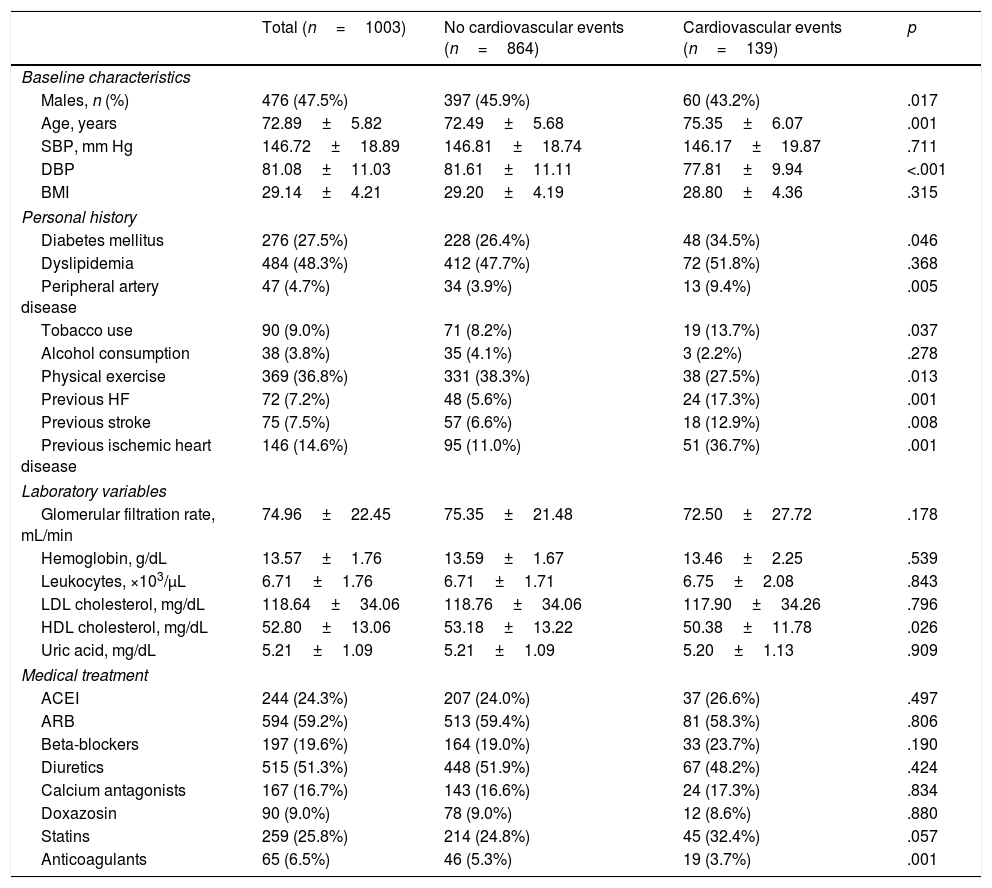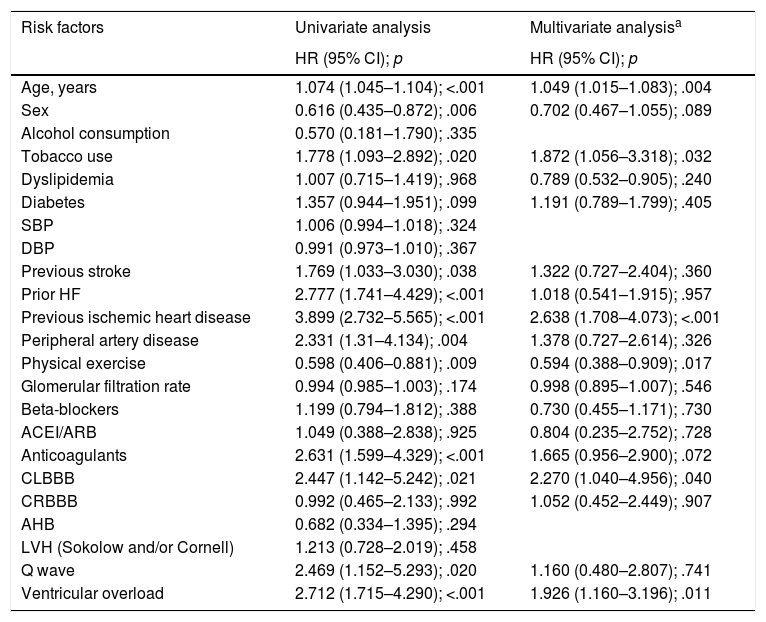Left ventricular hypertrophy is the most common marker of target organ damage in arterial hypertension. Electrocardiograms are typically performed to identify left ventricular hypertrophy. The aim of this study was to analyze the prognostic utility of other electrocardiographic abnormalities in patients with arterial hypertension, beyond ventricular hypertrophy.
Materials and methodsThe study included 1003 patients older than 65years with arterial hypertension. We recorded risk factors, previous cardiovascular history and medical treatment and analyzed various electrocardiographic abnormalities including the Sokolow-Lyon index, the Cornell index, ventricular overload and branch blocks. The study conducted a 2-year follow-up, recording the major cardiovascular events (mortality, myocardial infarction, stroke and hospitalization for heart failure).
ResultsThe study population's mean age was 72.9±5.8years, 47.5% of whom were men. During the follow-up, 13.9% of the patients experienced a major cardiovascular event. These patients were older, more often smokers and engaged in less physical exercise, without presenting differences in the antihypertensive therapy or blood pressure control. The ventricular overload pattern (HR: 1.93; 95% CI: 1.160–3.196; p=.011) and the complete left bundle branch block (HR: 2.27; 95% CI: 1.040–4.956; p=.040) behaved as independent electrocardiographic predictors of major cardiovascular events; however, left ventricular hypertrophy using the Sokolow and/or Cornell index did not behave as such.
ConclusionsFor patients with hypertension, the presence in the baseline electrocardiogram of complete left bundle branch block or a pattern of ventricular overload identifies a population at increased cardiovascular risk.
La hipertrofia ventricular izquierda es el marcador de daño de órgano diana más frecuente en la hipertensión arterial. Habitualmente se realiza un ECG para su identificación. El objetivo de este trabajo es analizar la utilidad pronóstica de otras alteraciones electrocardiográficas en pacientes hipertensos, más allá de la hipertrofia ventricular.
Materiales y métodosSe incluyeron 1.003 pacientes hipertensos mayores de65años. Se recogieron factores de riesgo, historia cardiovascular previa y tratamiento médico. Se analizaron diferentes alteraciones electrocardiográficas, incluyendo índice de Sokolow-Lyon, índice de Cornell, presencia de sobrecarga ventricular y bloqueos de rama, entre otros. Se llevó a cabo un seguimiento de 2años con recogida de eventos cardiovasculares mayores (mortalidad, infarto de miocardio, accidentes cerebrovascular o ingreso por insuficiencia cardiaca).
ResultadosLa edad media de la población era de 72,9±5,8años, con un 47,5% de varones. Durante el seguimiento el 13,9% sufrieron un evento cardiovascular mayor. Estos pacientes eran de mayor edad, más fumadores y practicaban menos ejercicio físico, sin presentar diferencias en el tratamiento antihipertensivo empleado ni en el control tensional. El patrón de sobrecarga ventricular (HR: 1,93; IC95%: 1,160-3,196; p=0,011) y el bloqueo completo de rama izquierda (HR: 2,27; IC95%: 1,040-4,956; p=0,040) se comportaron como factores electrocardiográficos predictores independientes de eventos cardiovasculares mayores, no así la hipertrofia ventricular izquierda por Sokolow y/o Cornell.
ConclusionesEn pacientes hipertensos, la existencia en el ECG basal de un bloqueo completo de rama izquierda o un patrón de sobrecarga ventricular identifica a una población de mayor riesgo cardiovascular.
Article
Diríjase desde aquí a la web de la >>>FESEMI<<< e inicie sesión mediante el formulario que se encuentra en la barra superior, pulsando sobre el candado.

Una vez autentificado, en la misma web de FESEMI, en el menú superior, elija la opción deseada.

>>>FESEMI<<<











